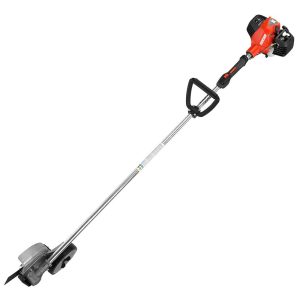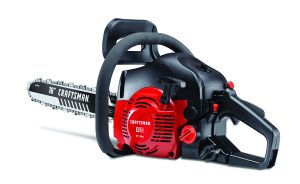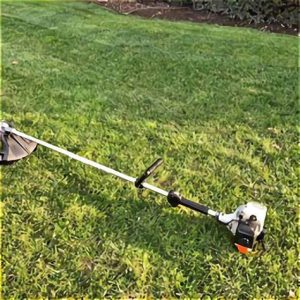Your Echo Leaf Blower is Running Rough: Fix it NOW!
A leaf blower is a great tool to have for your lawn care needs. It makes leaf removal less labor-intensive than using the traditional rake. When your leaf blower begins to run sluggish, your blower will not give you the power you need to move leaves and other debris.
An Echo leaf blower will run rough when the air filter is plugged or it isn’t getting good fuel flow due to a plugged air filter, clogged fuel lines, a bad fuel tank vent, or a dirty carburetor. A bad spark plug or plugged spark arrestor can also cause an Echo leaf blower to run rough and sluggish.
Follow the safety precautions listed in your owner’s manual when working on your leaf blower. Disconnect the spark plug and wait for all moving parts to stop before making any repairs.

This post may include affiliate links. Purchases made through these links may provide a commission for us, at no extra cost to you. As an Amazon Associate, we earn from qualifying purchases.
Follow all safety instructions provided in your equipment operator’s manual prior to diagnosing, repairing, or operating.Consult a professional if you don’t have the skills, or knowledge or are not in the condition to perform the repair safely.
Table of Contents
8 Reasons Your Echo Leaf Blower is Running Rough
Old or Bad Fuel in an Echo Leaf Blower
Old gas in your Echo leaf blower is one of the most common reasons it is running rough. Gas that sits in your fuel tank for a long time can cause fuel restrictions. When your leaf blower doesn’t get a good flow of fuel, it will run sluggish.
Ethanol, an alternative fuel found in most fuels today, attracts moisture out of the air. This water and ethanol mixture will leave behind gummy deposits in the fuel system. It can also cause corrosion in the fuel system.
Because gasoline can begin breaking down as quickly as 30 days after you buy it, it’s best to only purchase enough gas that can be consumed within 30 days.
If you have more fuel than you can use, be sure to add a fuel additive to stabilize the gas so it lasts a little longer without breaking down.
If you find old or bad gas in your leaf blower, empty the fuel tank and refill it with fresh fuel. Currently, Echo leaf blowers use 2-cycle engines which require an fuel and oil mix at the ratio of 50:1. This means 1 part oil is added to 50 parts gas.
Use unleaded gasoline with a minimum octane rating of 89 and a maximum ethanol content of 10%. The less ethanol in the fuel the better. Add a premium 2-cycle oil to the fuel like Echo PowerBlend.
Not using the correct gas and oil mix in a 2-cycle engine can damage the blower beyond repair. Read more in, “This is the Type of Gas and Oil Leaf Blower Use“.
Take note: While Echo doesn’t make a 4-cycle leaf blower as of this writing, some manufacturers are beginning to release 4-cycle leaf blowers. If you happen to have a 4-cycle leaf blower, do not mix oil with gas for these types of engines.
Solution: When you find you are running old gas, drain the fuel tank and fill it with fresh fuel. Use a stabilizer to keep the fuel running at its best. Some 2-cycle oils include a stabilizer. If yours does not, use a stabilizer like Sea Foam Motor Treatment.
Dirty Spark Plug in an Echo Leaf Blower
A fouled spark plug covered in dirt, carbon, and oil can experience intermittent spark issues that will make your Echo leaf blower run rough. A loose spark plug wire or a spark plug that is incorrectly gapped can also be responsible for a poorly running blower.
Solution: Remove the spark plug using a socket wrench. Check its condition. Replace the spark plug if you find the tip is very dark in appearance, the porcelain is cracked or the electrode is burnt.
You can also try to clean a dirty spark plug with a wire brush to reuse it.
I prefer to use a new spark plug since it is a crucial component to having a leaf blower operating at its best. Make sure you have a properly gapped spark plug using a feeler gauge. Install the new or clean spark plug and securely attach the spark plug wire.
Plugged Fuel Filter in an Echo Leaf Blower
When your Echo blower isn’t able to get a good flow of fuel out of the fuel tank because the fuel filter is plugged with dirt, the engine will run rough and you’ll experience a loss of power.
A fuel filter is used to strain the fuel before it enters the fuel system. You will find your fuel filter attached to the end of the fuel line inside the fuel tank.
Solution: A dirty and plugged fuel filter must be replaced. To do this, place your leaf blower on a flat surface.
Wipe any dirt from around the fuel cap and remove it. Using a bent clean wire, “fish” the filter out of the tank. Holding the fuel line and ring clip in one hand, securely grab the filter and pull it out of the fuel line.
Do not lose the ring clip and keep it on the fuel line. Install a new fuel filter into the end of the fuel line. Slide the ring clip so it sits over the fuel line and fuel filter male end to secure the filter to the fuel line.
Clogged Fuel Lines in an Echo Leaf Blower
Old fuel can clog the leaf blower’s fuel line restricting fuel flow. Look for a clogged line or a line that may have gotten pinched or kinked.
Solution: Replace any damaged or clogged fuel line with a new piece of fuel line of the same length and diameter. It’s also a good idea to replace the fuel line if it appears dry and cracked before your run into additional problems.
Plugged Fuel Tank Vent in an Echo Leaf Blower
The fuel tank vent can become plugged or damaged preventing air from passing through the vent to equalize the air pressure in the fuel tank. A plugged vent can cause a vacuum to form in the fuel tank. This keeps fuel from flowing out of the tank.
If fuel isn’t running through the fuel lines and you don’t have a clogged line or a plugged fuel filter, there is a good chance the fuel tank vent is plugged. You can test this by loosening or removing the blower’s fuel cap to allow air into the tank. Start the blower, and allow it to run.
Be careful and keep your leaf blower level so you don’t spill any gas from the tank. If the blower runs strong and doesn’t bog down and run rough, tighten the fuel cap and see if you can replicate the issue to confirm the fuel tank vent is the problem.
Solution: Replace the fuel tank vent if your blower starts to act up and run rough again after installing the fuel cap.
Plugged Air Filter in an Echo Leaf Blower
An Echo leaf blower will run rough and bog down when it isn’t able to get air to the engine. This can happen when the air filter becomes plugged with dirt and debris when the filter isn’t regularly cleaned or replaced.
Because a leaf blower stirs up all kinds of dirt and debris, it’s important to always run an air filter. Without it, dirt can enter the engine and cause significant engine damage. It’s good practice to replace your air filter annually and clean it several times throughout the year.
Solution: If you find your air filter is plugged, I recommend replacing it with a new one. It is an important component when it comes to protecting the engine.
A foam, fabric or felt-style filter can be cleaned using mild detergent and water. Wash the filter to remove as much dirt as possible. Rinse until clear.
A paper filter can be cleaned by knocking it against a solid surface to remove as much dirt as possible. Hold it up to a light source to see if you can see light through the element.
Reuse the filter if you can still see light. Replace the filter if you cannot see light, your filter is very dirty or it is covered in oil.
Because there are different types of filters used in Echo leaf blowers, refer to your operator’s manual for the steps to clean your model blower.
Dirty Carburetor in an Echo Leaf Blower
The carburetor’s function is to regulate the amount of fuel mixed with air to create a combustion so your blower will continue to run.
When the carburetor gets gummed up and dirty from running old fuel, the fuel flow can be restricted. This will prevent the engine from getting the fuel it requires and it will begin running sluggishly.
Solution: You may be able to clean your carburetor by removing it and using carburetor cleaner to get it working again. You may end up having to rebuild the carburetor or replace it if cleaning does not help. Not all Echo carburetors will have build kits available.
Plugged Spark Arrestor in an Echo Leaf Blower
There is a small metal screen that keeps hot exhaust material from shooting out of your Echo leaf blower and causing injury or starting a fire. This small screen will become plugged with a carbon buildup that will affect how the engine runs.
Solution: Disconnect the spark plug wire. Remove the engine cover and the engine exhaust cover. Carefully remove the spark arrestor screen. You can either clean it with a metal brush or a torch.
If you choose to use a torch, protect your hands and eyes. Hold the screen away from your body using pliers. Torch the screen to burn off the soot buildup. Wait for the screen to cool and reinstall it. Reattach the engine exhaust cover and engine cover. Reattach the spark plug wire.
If the screen isn’t able to be sufficiently cleaned or you find it is damaged or has a hole in it, replace it with a new spark arrestor screen.







